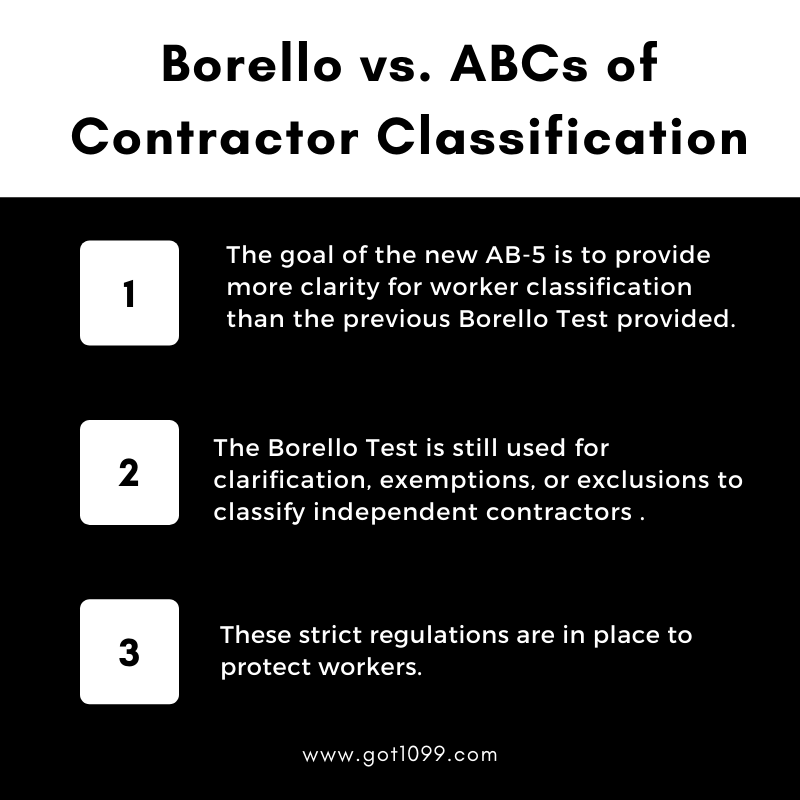The California Employment Development Department (EDD) uses the new Assembly Bill 5’s ABC test to identify worker classification. However, the older Borello Test can also be used in less clear classification circumstances.
When it comes to correctly classifying your workers, how do you know which test to use and when? Let’s dive in.
The ABC Test vs. the Borello Test
Both the ABC test and the Borello test were created with the intention of forming regulations for business owners to follow in order to correctly classify each of their workers between W-2 employees and 1099 workers.
What is AB-5?
Assembly Bill-5, passed January 1st, 2020, set a new rule and standard for classifying workers as either W-2 employees or 1099 independent contractors. While business owners can hire both workers for their business, classifying each individual correctly keeps your business from triggering an EDD audit due to misclassifications.
The goal of the new AB-5 is to provide more clarity for worker classification than the previous Borello Test provided. The process starts by asking who has the “right of control” of the worker? This essentially asks who has the right to control how or when the worker performs job tasks and shows up.
W-2 employees work pre-determined hours, receive benefits, time off, are taxed on payroll, do not have a set work end date, and perform job tasks. However, it’s the opposite for 1099 employees. They have work flexibility, do not receive benefits or time off, their payments are not pre-taxed, and they have a broader range of work flexibility.
AB-5 California put in place a new worker classification test called the ABCs of worker classification. This test is simpler and only asks business owners three questions to determine classification status.
Under the ABC test, a worker is considered an employee and not an independent contractor, unless the hiring entity satisfies all three of the following conditions:
- The worker is free from the control and direction of the hiring entity in connection with the performance of the work, both under the contract for the performance of the work and in fact;
- The worker performs work that is outside the usual course of the hiring entity’s business; and
- The worker is customarily engaged in an independently established trade, occupation, or business of the same nature as that involved in the work performed.
What is the Borello Test?
Before the new Assembly Bill 5 classification guidelines, the Borello test classified workers as either W-2 employees or 1099 independent contractors. This test is less straightforward than the updated AB-5 that includes clearer guidelines under its ABC test.
Even with the new AB-5 regulations, however, you can still reference the Borello test if there are exemptions, exclusions, or confusion in classifying independent contractors. Workers exempt from the ABC Test are not automatically considered independent contractors and must also meet the Borello factor’s requirements to be considered independent contractors.
EDD provides the full Borello Test worksheet with the following questions to help guide classification:
- Do you instruct or supervise the person while he or she is working?
- Can the worker quit or be discharged (fired) at any time?
- Is the work being performed part of your regular business?
- Does the worker have a separately established business?
- Is the worker free to make business decisions that affect his or her ability to profit from the work?
- Does the individual have a substantial investment in their job which would subject him or her to the financial risk of loss?
- Do you have employees who do the same type of work?
- Do you furnish the tools, equipment, or supplies used to perform the work?
- Is the work considered unskilled or semi-skilled labor?
- Do you provide training for the worker?
- Is the worker paid a fixed salary, an hourly wage, or based on a piece-rate basis?
- Did the worker previously perform the same or similar services for you as an employee?
- Does the worker believe that he or she is an employee?
Answering “yes” to questions 1-3 would provide a strong indication that the worker is an employee. Answering “no” to questions 4-6 would indicate that a worker is not in business for themselves and would likely classify as an employee. Questions 7-13 indicate important factors to be considered.
While answering “yes” to any one of them may indicate that a worker should be classified as an employee, no single factor is enough to determine so independently.
The full worksheet provided by EDD provides further clarification on certain factors and circumstances.
If completing the provided worksheet does not provide sufficient clarification for employers, EDD offers the ability to request a written ruling by completing a seven-page form called Determination of Employment Work Status. The form supports any business entity looking to determine if a worker is an employee or an independent contractor.
Click here to read the list of occupational, professional, referral agency, and construction agency exemptions that business owners must be aware of to reference the 13 factors in the Borello test when hiring workers in these fields.
Why is Proper Classification Important?
EDD takes classification seriously and performs thorough audits because they directly impact payroll taxes—essentially the money the government receives. The agency doesn’t receive proper taxes owed from the business owner or the hired workers when they are misclassified.
These strict regulations are in place to protect workers. Workers misclassified as 1099 independent contractors, when they are truly W-2 employees, do not receive the same type of benefits, such as employment benefits they are entitled to. Curious what inspired California EDD to create stronger classification criteria? Read this ebook guide to the Dynamex Case that triggered AB-5 here.
For employers looking to quickly verify their worker’s correct classification status, purchase a got1099 report. Our reporting system is quick and simple for you to fill out and get back. Unlike the seven-page handwritten EDD Determination of Employment Work Status, our report takes less time to fill out. We provide detailed information on each individual worker you request verification of, including:
- EIN
- SSN
- Business location
- Business entity review
- FBN review
- Website and social media checks
- Media data
- Professional license check
- Tax license check
The got1099 report helps give you clear facts to make better classification decisions. The benefit? If we find that you’ve misclassified a worker, you now know the right steps to take to help classify them correctly. Contact us today to learn more about how a got1099 report can help your business.

LOCATION
La Jolla, CA 92037
o: (888) got-1099 (468-1099)
e: contact@got1099.com
copyright got1099®
copyright got1099?®
copyright Start1099®
GET AB-5 And CASLB Updates in your inbox
IMPORTANT INFO
Disclaimer
got1099 is a business reporting company providing business analysis reports to companies re: their 1099 independent contractors We do not provide legal advice. Consult with your attorney relating to any legal issues.


